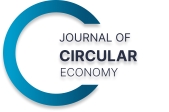On Circularity, Complexity and (Elements of) Hope
Abstract
A truly sustainable circular economy is more than just recycling, making it a complex matter. We argue that reducing complexity will ease the path to circular economy. Complexity reduction potential lies in lower material diversity, increasing accessibility and intuitive use for consumers, as well as simplifying business operations.
DOI: https://doi.org/10.55845/WNHN7338
References
Ayres, R. (1999). The second law, the fourth law, recycling and limits to growth. Ecological Economics, 29, 473-483. https://doi.org/10.1016/S0921-8009(98)00098-6
Blum, N., Haupt , M., & Benning, C. (2020). Why «Circular» doesn’t always mean «Sustainable». Resources, Conservation and Recycling, 162. https://doi.org/10.1016/j.resconrec.2020.105042
Ceballos, G., Ehrlich, P. R., & Raven, P. H. (2020). Vertebrates on the brink as indicators of biological annihilation and the sixth mass extinction. Proc Natl Acad Sci U S A, 117(24), 13596-13602. https://doi.org/10.1073/pnas.1922686117
Circle economy. (2021). Circularity Gap Report. circularity-gap.world
Desing, H. (2021). Product and Service Design for a Sustainable Circular Economy (Publication Number 27225) ETH Zürich]. Zürich.
Desing, H. (2022). Below zero. Environmental Science: Advances, 612-619. https://doi.org/10.1039/d2va00168c
Desing, H., Braun, G., & Hischier, R. (2020). Ecological resource availability: a method to estimate resource budgets for a sustainable economy. Global Sustainability, 3, 1-11. https://doi.org/10.1017/sus.2020.26
Desing, H., Braun, G., & Hischier, R. (2021). Resource pressure – A circular design method. Resources, Conservation and Recycling, 164. https://doi.org/10.1016/j.resconrec.2020.105179
Desing, H., Brunner, D., Takacs, F., Nahrath, S., Frankenberger, K., & Hischier, R. (2020). A circular economy within the planetary boundaries: Towards a resource-based, systemic approach. Resources, Conservation and Recycling, 155. https://doi.org/10.1016/j.resconrec.2019.104673
Desing, H., & Widmer, R. (2021). Reducing climate risks with fast and complete energy transitions: applying the precautionary principle to the Paris agreement. Environmental Research Letters, 16(12), 121002. https://doi.org/10.1088/1748-9326/ac36f9
Desing, H., Widmer, R., Beloin-Saint-Pierre, D., Hischier, R., & Wäger, P. (2019). Powering a Sustainable and Circular Economy—An Engineering Approach to Estimating Renewable Energy Potentials within Earth System Boundaries. Energies, 12(24), 1-18. https://doi.org/10.3390/en12244723
Diederen, A. (2010). Global Resource Depletion, Managed Austerity and the Elements of Hope. Eburon.
Elhacham, E., Ben-Uri, L., Grozovski, J., Bar-On, Y. M., & Milo, R. (2020). Global human-made mass exceeds all living biomass. Nature, 588(7838), 442-444. https://doi.org/10.1038/s41586-020-3010-5
Gomes, G. M., Moreira, N., & Ometto, A. R. (2022). Role of consumer mindsets, behaviour, and influencing factors in circular consumption systems: A systematic review. Sustainable Production and Consumption, 32, 1-14. https://doi.org/10.1016/j.spc.2022.04.005
Haupt, M., Waser, E., Wurmli, J. C., & Hellweg, S. (2018). Is there an environmentally optimal separate collection rate? Waste Manag, 77, 220-224. https://doi.org/10.1016/j.wasman.2018.03.050
Hummen, T., & Desing, H. (2021). When to replace products with which (circular) strategy? An optimization approach and lifespan indicator. Resources, Conservation and Recycling, 174. https://doi.org/10.1016/j.resconrec.2021.105704
Kral, U., Kellner, K., & Brunner, P. H. (2013). Sustainable resource use requires “clean cycles” and safe “final sinks”. Science of the Total Environment, 461-462, 819-822. https://doi.org/10.1016/j.scitotenv.2012.08.094
Lama, V., Righi, S., Quandt, B. M., Hischier, R., & Desing, H. (2022). Resource Pressure of Carpets: Guiding Their Circular Design. Sustainability, 14(5), 2530. https://doi.org/10.3390/su14052530
Milios, L. (2022). Engaging the citizen in the circular economy: Transcending the passive consumer role. Frontiers in Sustainability, 3. https://doi.org/10.3389/frsus.2022.980047
Mostaghel, R., & Chirumalla, K. (2021). Role of customers in circular business models. Journal of Business Research, 127, 35-44. https://doi.org/10.1016/j.jbusres.2020.12.053
Murphy, T. W. (2022). Limits to economic growth. Nature Physics, 18(8), 844-847. https://doi.org/10.1038/s41567-022-01652-6
Schäfer, P. (2021). Recycling – ein Mittel zu welchem Zweck? Modellbasierte Ermittlung der energetischen Aufwände des Metallrecyclings für einen empirischen Vergleich mit der Primärgewinnung. Springer Spektrum. https://doi.org/10.1007/978-3-658-32924-2
Takacs, F., Stechow, R., & Frankenberger, K. (2020). Circular ecosystems – Business model innovation for the circular economy. In Institute of Management and Strategy University of St. Gallen (Ed.).
United Nations Environment Programme. (2019). Minamata convention on Mercury. www.mercuryconvention.org
Wiprächtiger, M., Haupt, M., Heeren, N., Waser, E., & Hellweg, S. (2020). A framework for sustainable and circular system design: Development and application on thermal insulation materials. Resources, Conservation and Recycling, 154. https://doi.org/10.1016/j.resconrec.2019.104631
Zepf, V., Reller, A., Rennie, C., Ashfield, M., & Simmons, J. (2014). Materials critical to the energy industry – An introduction (2 ed.).
How to Cite This Article
Desing, H., & Blum, N. (2023). On circularity, complexity and (elements of) hope. Journal of Circular Economy, 1(1), 1–6. https://doi.org/10.55845/wnhn7338
Copyright
Open Access: This article is licensed under a Creative Commons Attribution 4.0 International License, which permits use, sharing, adaptation, distribution and reproduction in any medium or format, as long as you give appropriate credit to the original author(s) and the source, provide a link to the Creative Commons licence, and indicate if changes were made. The images or other third-party material in this article are included in the article’s Creative Commons licence, unless indicated otherwise in a credit line to the material. If material is not included in the article’s Creative Commons licence and your intended use is not permitted by statutory regulation or exceeds the permitted use, you will need to obtain permission directly from the copyright holder. To view a copy of this licence, visit http://creativecommons.org/licenses/by/4.0/.
License
Under a Creative Commons license
Author Notes
- Harald Desing [1], Nicola Blum [2]
- [1] Empa – Swiss Federal Laboratories for Materials Science and Technology, Technology and Society Laboratory, Lerchenfeldstrasse 5, 9014 St. Gallen, Switzerland, [email protected]
- [2] BFH – Bern University of Applied Sciences, Institute for Sustainable Business, Brückenstrasse 73, 3005 Bern, Switzerland, [email protected]
Published Details: Received 29 November 2022, Accepted 16 December 2022, available online 6 January 2023
